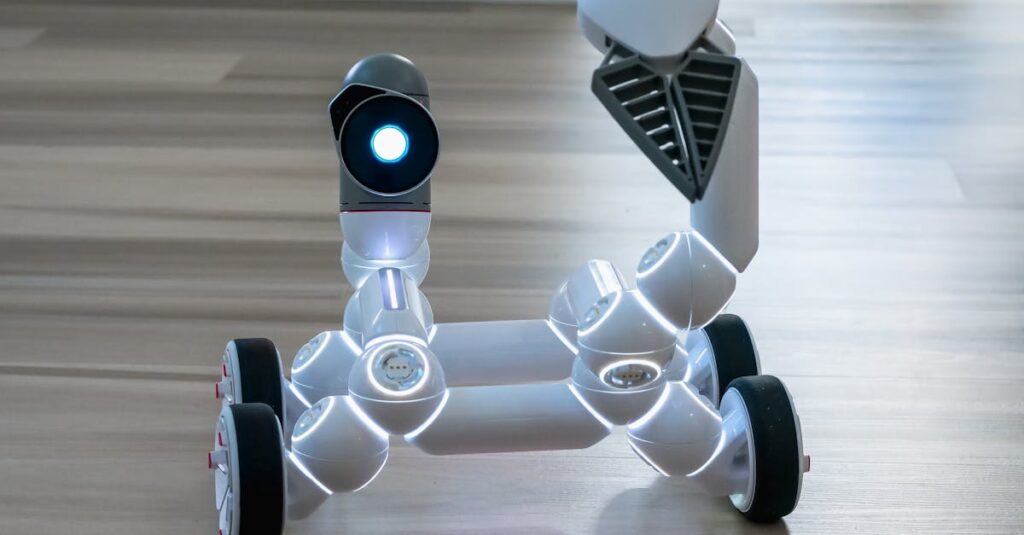Table of Contents
ToggleAs the world hurtles toward an era where everything from your fridge to your light bulbs can chat with each other, the concept of smart homes isn’t just a sci-fi fantasy anymore. It’s a reality that’s knocking at our doors—sometimes literally, thanks to smart doorbells. Imagine a home that knows your coffee preference better than your best friend does. Sounds dreamy, right?
In the coming years, smart home technology is set to evolve at lightning speed. From AI-driven assistants that can predict your needs to appliances that practically run themselves, the future is looking bright—like your smart LED lights on a Saturday night. Buckle up as we dive into the trends shaping our homes, making them smarter, safer, and a tad more entertaining than your average sitcom.
Overview of Smart Home Technology
Smart home technology has progressed significantly, going from futuristic dreams to everyday realities. Devices like smart speakers, security cameras, and thermostats offer convenience and customization in daily life. Homeowners enjoy enhanced control over their environments through smartphone apps and voice commands, creating seamless integration across various systems.
IoT (Internet of Things) connects these devices, allowing them to communicate and collaborate effectively. For example, smart lighting systems adjust based on user preferences, while smart locks offer advanced security features. Energy management also plays a vital role, with smart thermostats optimizing heating and cooling to reduce costs.
User data drives personalization, enabling devices to learn routines and preferences. This technology prevents energy waste and ensures homes maintain comfortable conditions. Consumers are increasingly drawn to automation, using sensors and timers to enhance safety and efficiency.
Integration with smart speakers like Google Home and Amazon Alexa amplifies user engagement. Homeowners can manage multiple devices through simple voice commands. Compatibility across different platforms improves ecosystem functionality, sparking innovative trends in smart home technology.
Emerging technologies like AI and machine learning further enhance these systems. These advancements enable devices to predict future behaviors, making homes more intuitive. The drive towards interoperability ensures that diverse smart devices work together efficiently, enhancing user experience.
With ongoing developments, smart home technology evolves to meet the rising demand for convenience, energy efficiency, and security. Users increasingly value the ability to monitor their homes remotely, turning routine tasks into automated experiences.
Current Trends in Smart Homes
Smart home technology showcases significant advancements, resulting in increased convenience and efficiency. Homeowners benefit from the continuous integration of smart devices into daily life.
Integration of IoT Devices
IoT devices create a cohesive ecosystem in smart homes, enabling seamless communication. Smart thermostats, lights, and security cameras connect to central systems, enhancing functionality. Users manage multiple devices through single interfaces on their smartphones or computers. This integration streamlines energy usage, monitoring capabilities, and security responses. Significant data exchange allows devices to learn preferences and optimize settings, thus improving user experience. Smart kitchens equipped with integrated appliances further illustrate IoT’s growing influence.
Voice Assistants and Smart Speakers
Voice assistants and smart speakers play a pivotal role in smart home interactions. Devices like Amazon Echo and Google Home enable simple voice commands for controlling various systems. Functions extend beyond music playback to include managing lighting, temperature, and security features. Users appreciate convenience as they engage these devices throughout the day. Compatibility with a broad range of IoT devices enhances their usefulness. With ongoing improvements in natural language processing, voice interfaces become more intuitive, fostering user engagement and satisfaction.
Emerging Technologies Shaping the Future
Emerging technologies are central to the evolution of smart homes, transforming how people interact with their living spaces.
Artificial Intelligence in Smart Homes
Artificial intelligence greatly enhances smart home functionality. Devices equipped with AI can learn user preferences over time, allowing for customized environments. For example, smart thermostats adjust temperature settings based on individual routines, ultimately improving comfort and energy efficiency. AI algorithms analyze data from various sensors, making real-time adjustments that adapt to changing conditions. Furthermore, machine learning models predict user behavior, resulting in a seamless user experience. Automation improves household management by anticipating needs, thus making daily life more convenient.
Advanced Security Features
Advanced security features are pivotal in increasing homeowner confidence. Smart locks and cameras provide real-time surveillance and remote access, ensuring enhanced protection. Users can monitor their properties through smartphone apps that send instant alerts for unusual activities. Integration of facial recognition technology allows for authorized access, improving home security. Moreover, cybersecurity measures protect against unauthorized access, preserving user data integrity. As innovation continues, these security systems offer more robust protection, responding effectively to emerging threats, and they help create safer living environments.
Sustainability and Energy Efficiency
Sustainability and energy efficiency stand at the forefront of smart home future trends. Eco-conscious homeowners increasingly seek solutions that reduce their environmental footprint while enhancing comfort.
Renewable Energy Solutions
Solar panels and wind turbines become popular choices for homeowners adopting renewable energy solutions. These technologies allow people to generate clean, renewable electricity from natural resources. Many systems integrate seamlessly with smart home setups, enabling real-time monitoring of energy production and consumption. Battery storage systems further enhance these solutions by storing excess energy for later use. Homeowners can minimize reliance on traditional power grids while benefiting from incentives and rebates offered for using renewable energy.
Smart Energy Management Systems
Smart energy management systems transform how households use energy. Devices like smart meters provide insights into energy consumption patterns, allowing users to identify inefficiencies. By adjusting energy use according to peak and off-peak times, households can significantly lower utility bills. Automation features enable devices to operate when energy demand is low, maintaining comfort without excessive costs. Additionally, integration with smart thermostats and sensors ensures optimal energy use throughout the home, creating a more sustainable living environment.
Impact on Daily Life
Smart home technology significantly reshapes daily routines, providing a blend of convenience and efficiency. Homeowners benefit from automation, which simplifies tasks such as adjusting lighting and managing appliances. Control occurs conveniently through smartphone applications or voice commands, allowing users to interact with their environments easily.
Daily energy management offers meaningful savings. Smart thermostats learn preferences and adjust accordingly, using data to optimize heating and cooling. This capability not only enhances comfort but also reduces energy waste, aligning with eco-friendly practices. Beyond energy, security features like smart locks and surveillance cameras ensure peace of mind for families.
Greater integration among devices fosters a cohesive ecosystem. Various products, including smart bulbs and security systems, communicate seamlessly, streamlining user experiences. Users can manage multiple devices via single interfaces, facilitating efficient monitoring and quick responses to alerts or changes.
Voice assistants enhance interactions within smart homes. Devices like Amazon Echo and Google Home serve as central control points, executing various tasks with simple commands. Their improved natural language processing continues to enrich user engagement, making these interactions intuitive and responsive to individual preferences.
Adaptability of smart home systems allows for personalization in real-time. Advanced technology actively learns user routines, adjusting home environments accordingly. Smart home products not only fit seamlessly into lived experiences but also evolve alongside user needs, ensuring ongoing satisfaction and enhanced living conditions.
Sustainability emerges as a crucial consideration in household decision-making. As interest in renewable energy solutions grows, homeowners seek to lessen their environmental footprint. Access to real-time insights into energy consumption empowers users to make informed decisions, fostering an eco-conscious lifestyle while enjoying modern conveniences.
The future of smart homes is bright with endless possibilities. As technology continues to evolve homeowners can expect even greater convenience and efficiency. The integration of AI and machine learning will make homes more intuitive and responsive to individual needs.
Sustainability will also play a crucial role as eco-conscious solutions gain traction. Smart energy management systems will empower users to monitor and optimize their consumption. With ongoing advancements in smart home technology the way people interact with their living spaces will transform dramatically.
This shift not only enhances comfort and security but also fosters a more sustainable lifestyle. As smart homes become increasingly interconnected they will redefine the concept of modern living.







